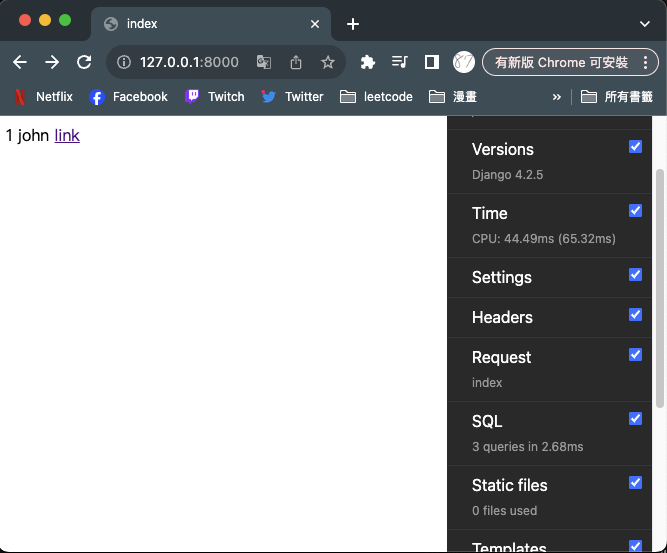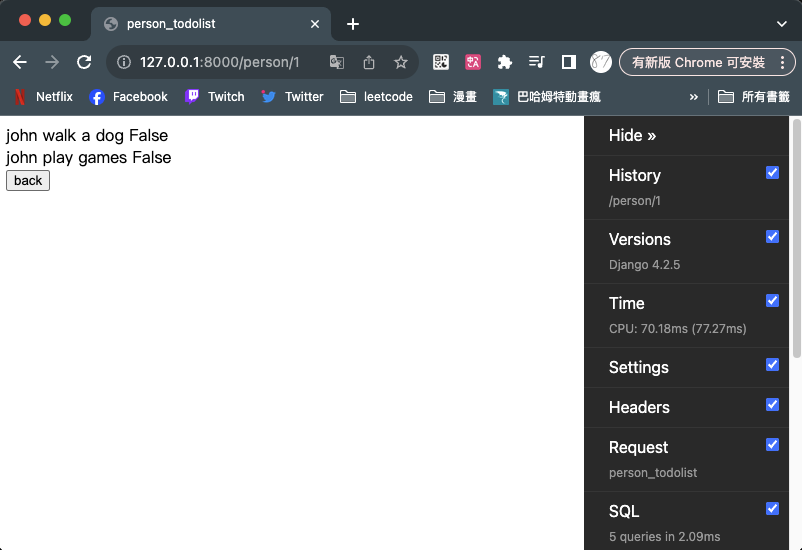今天就來看看ORM組成的SQL都長什麼樣子吧,怎麼看呢?當然是用我們昨天設定好的logging或是debug toolbar來看囉!
我們先來修改一下models.py
from django.db import models
from django.utils import timezone
# Create your models here.
class Person(models.Model):
class Sex(models.IntegerChoices):
MALE = 0
FEMALE = 1
THIRD = 2
name = models.CharField(max_length=255)
sex = models.IntegerField(choices=Sex.choices)
class Meta:
db_table = "person"
class Todo(models.Model):
owner = models.ForeignKey(Person, on_delete=models.CASCADE)
title = models.CharField(max_length=255)
complete = models.BooleanField(default=False)
add_date = models.DateField(default=timezone.now)
class Meta:
db_table = "todo_list"
然後在settings.py加上templates的位置
TEMPLATES = [
{
'BACKEND': 'django.template.backends.django.DjangoTemplates',
'DIRS': ["templates"], # 這邊是更動處
'APP_DIRS': True,
'OPTIONS': {
'context_processors': [
'django.template.context_processors.debug',
'django.template.context_processors.request',
'django.contrib.auth.context_processors.auth',
'django.contrib.messages.context_processors.messages',
],
},
},
]
加完之後在跟manage.py同階層的資料夾下新增一個資料夾templates
然後我們這邊加兩個檔案
內容如下
<!-- index.html -->
<!DOCTYPE html>
<html lang="en">
<head>
<meta charset="UTF-8">
<meta http-equiv="X-UA-Compatible" content="IE=edge">
<meta name="viewport" content="width=device-width, initial-scale=1.0">
<title>index</title>
</head>
<body>
{% for p in person %}
{{p.id}}
{{p.name}}
<a href="person/{{p.id}}"> link </a>
{% endfor %}
</body>
</html>
<!-- person_todolist.html -->
<!DOCTYPE html>
<html lang="en">
<head>
<meta charset="UTF-8">
<meta http-equiv="X-UA-Compatible" content="IE=edge">
<meta name="viewport" content="width=device-width, initial-scale=1.0">
<title>Document</title>
</head>
<body>
{% if todo %}
{% for t in todo %}
{{t.owner.name}}
{{t.title}}
{{t.complete}}
<br/>
{% endfor %}
{% else %}
no todo list
{% endif %}
<button onclick="back()">back</button>
<script>
function back(){
history.back()
}
</script>
</body>
</html>
版面我就不管啦XD
接下來我們去hello_app中的views.py新增
# views.py
from django.shortcuts import render
from django.http import HttpResponse
from .models import Person, Todo
# Create your views here.
def hello(request):
return HttpResponse("Hello World!")
def index(request):
p = Person.objects.all()
return render(request, 'index.html', {"person": p})
def person_todolist(request, id):
todo = Todo.objects.filter(owner=id)
return render(request, 'person_todolist.html', {"todo": todo})
接著是urls.py
# urls.py
from django.urls import path
from . import views
urlpatterns = [
path('hello/', views.hello),
path('', views.index),
path('person/<int:id>', views.person_todolist)
]
這樣我們前置作業就完成了!來看看ORM的SQL吧!
首先先在admin新增幾筆資料~
新增完後到127.0.0.1:8000應該就會看到類似下圖這樣,會有你新增的角色person
然後能從console看到(0.000) SELECT "person"."id", "person"."name", "person"."sex" FROM "person"; args=(); alias=default
也能從debug toolbar看到
接著再點link
可以看到該person的todolist事項~(我這邊沒給他完成,過幾天我們在做個完整版的今天先看看ORM~)
一樣debug toolbar和console都能看到SQL
(0.000) SELECT "todo_list"."id", "todo_list"."owner_id", "todo_list"."title", "todo_list"."complete", "todo_list"."add_date" FROM "todo_list" WHERE "todo_list"."owner_id" = 1; args=(1,); alias=default
(0.000) SELECT "person"."id", "person"."name", "person"."sex" FROM "person" WHERE "person"."id" = 1 LIMIT 21; args=(1,); alias=default
(0.000) SELECT "person"."id", "person"."name", "person"."sex" FROM "person" WHERE "person"."id" = 1 LIMIT 21; args=(1,); alias=default

這邊就有個疑問了!為什麼他明明都是同一個人卻要select兩次呢?
那是因為我們的views.py那邊寫這樣
todo = Todo.objects.filter(owner=id)
這個會導致django重複搜尋,現在只有一兩筆資料所以影響不大,資料量一多DB就要多搜尋好幾次很吃效能的!
所以當有兩個table FK關聯時,這正確的寫法要這樣讓django先去下join
todo = Todo.objects.select_related("owner").filter(owner=id)
那我們再來看改過的~
(0.000) SELECT "todo_list"."id", "todo_list"."owner_id", "todo_list"."title", "todo_list"."complete", "todo_list"."add_date", "person"."id", "person"."name", "person"."sex" FROM "todo_list" INNER JOIN "person" ON ("todo_list"."owner_id" = "person"."id") WHERE "todo_list"."owner_id" = 1; args=(1,); alias=default

摁~只要select一次,完美!
django的ORM隨著專案的龐大,資料庫的結構複雜化後會有很多有趣的用法,雖然真的太複雜還是直接寫SQL比較優~
有了這兩種方式可以查看SQL後,這樣就再也不用怕自己寫的ORM是不是生出來的SQL會嚴重影響效能了,可以直接查看生成後的SQL來確認是不是自己想要的SQL!
